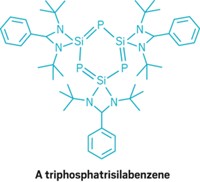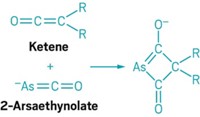Advertisement
Grab your lab coat. Let's get started
Welcome!
Welcome!
Create an account below to get 6 C&EN articles per month, receive newsletters and more - all free.
It seems this is your first time logging in online. Please enter the following information to continue.
As an ACS member you automatically get access to this site. All we need is few more details to create your reading experience.
Not you? Sign in with a different account.
Not you? Sign in with a different account.
ERROR 1
ERROR 1
ERROR 2
ERROR 2
ERROR 2
ERROR 2
ERROR 2
Password and Confirm password must match.
If you have an ACS member number, please enter it here so we can link this account to your membership. (optional)
ERROR 2
ACS values your privacy. By submitting your information, you are gaining access to C&EN and subscribing to our weekly newsletter. We use the information you provide to make your reading experience better, and we will never sell your data to third party members.
Synthesis
Arsenicin A: A Unique Natural Product
Chemists report the synthesis and structure of the first known natural product to contain multiple arsenic atoms
by Stephen K. Ritter
December 21, 2009
| A version of this story appeared in
Volume 87, Issue 51
Chemists in Australia are reporting the synthesis and crystal structure of arsenicin A, the first known natural product to contain multiple arsenic atoms (Organometallics, DOI: 10.1021/om900998q). This tetraarsenic cluster compound has been isolated in trace amounts from a New Caledonian sponge in the southwest Pacific Ocean and shown to possess potent bactericidal and fungicidal activities against human pathogens. In addition, arsenic trioxide (As2O3) is already an effective approved drug for treating acute myeloid leukemia. With the prospects for new arsenic drug development at hand, S. Bruce Wild and coworkers of Australian National University, Canberra, took on the challenge of synthesizing arsenicin A. The team started by converting methylenebis(phenylarsinic acid) into a linear tetraarsine derivative. Replacing the phenyl groups with iodine followed by hydrolysis and then dehydration steps sewed up the tetraarsine into the desired adamantane-type structure, which has four arsenic stereocenters. The cage structure is similar to that of As4O6, but with three methylene groups replacing three oxygen atoms. The novel structure raises questions about how arsenicin A’s biosynthesis unfolds, Wild and coworkers say. “It is hoped that the synthesis presented here will facilitate further chemical and biological work on this unusual natural product,” they write.





Join the conversation
Contact the reporter
Submit a Letter to the Editor for publication
Engage with us on Twitter